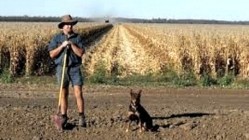Australian grain yields up, but aphid could lead to big crop losses

The Australian Bureau of Agricultural and Resource Economics and Sciences (Abares) predicted the next grain crops to weigh in at 8m tonnes, compared to the 7.2m tonnes harvested in the state last season—though well short of the record harvest of 10.34m tonnes reaped in 2010-11.
Yet the identification of the Russian wheat aphid in the state has put a damper on expectations. It was found for the first time in Australia in the Tarlee area in mid-May, and is now widespread across the eastern part of South Australia and in western Victoria. Some crops have been sprayed and have recovered rapidly with no re-infestation.
Darren Arney, chief executive of Grain Producers SA, the industry body, said it was too early to tell what effect the aphid outbreak would have.
“It’s been identified but because the weather’s been cool they haven’t been active,” he said.
“They become active when the weather warms up and that’s when we’ll know if we’ve got a problem or not.”
Arney said good early spring rainfall across the state since the report was compiled would also help.
However, some areas, including Kangaroo Island and parts of Yorke Peninsula, are becoming too wet, which could lead to waterlogged soil and reduced yields.
Other areas which has been dogged by several seasons of low rainfall are now on track to record an above-average crop for the first time in a number of years.
“Overall it’s looking very good and better than where we were at this time last year, and we went on to produce 7.2m tonnes,” he said.
“Grain prices have come back significantly—by 25-30%—on last harvest so even though the production is up, the gross income could be down for some farmers.”
However, Arney said high-value pulse crops such as lentils, peas and fava beans were being planted in greater numbers and were also enjoying a good season.
In South Australia, the total area planted to winter crops is estimated to have risen by 2.6% to 3.7m hectares this year.
Upcoming wheat production is forecast to rise by 14% to 5m tonnes, reflecting a 5% increase in the area planted and an 8.8% rise in the yield.
Barley production is expected to decline by 1.6% to 1.9m tonnes, representing a 3.7% decline in planted area, offset by a 2.1% rise in the yield.
Canola production is predicted to rise by 18% to 350,000 tonnes, with planted areas rising by 2.2% and a 16% yield increase.
National winter crop production in 2016–17 is estimated to be 46.1m tonnes, 13% above the five-year average, and up 16%—or 6.5m tonnes—on 2015–16.
For the first time since 2007–08 winter crop production is forecast to rise across all Australian states.
South Australian harvesting is expected to begin in mid-October and be completed by the end of the year, depending on spring temperatures and soil types.












